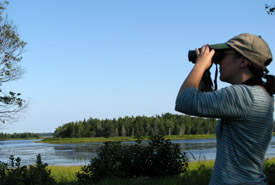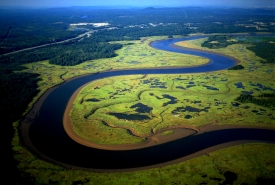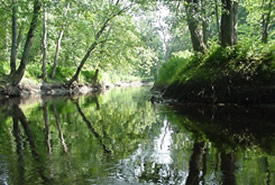Caring for Canada's wetlands

Birding at the Tabusintac Estuary, NB (Photo by NCC)
If you used water today to brush your teeth, cook or quench your thirst, you should probably thank a wetland! World Wetlands Day, celebrated every February 2, is an opportunity to learn about the value and importance of wetlands to Canadians.
If you’re wondering why you should care, consider what wetlands do for us.
From providing ecological services such as flood control and carbon storage to food production, wetlands play a vital role in our day-to-day lives.
Wetlands are good for your health. They play a key role in removing sediments, excess nutrients and even bacteria from drinking water. Over two-thirds of Canadians get their drinking water from lakes, rivers and reservoirs, and the quality of that water depends on the health of the watershed, including wetlands. Like giant sponges, wetlands also absorb and replenish water to buffer our communities from flood and drought risks.
Wetlands are vital nesting and feeding grounds for waterfowl, they provide nursery habitat for fishes and are one of Canada’s most diverse ecosystems. At least half of our wildlife species rely on wetlands for at least part of their lifecycle.
Canada is home to 25 percent of the world’s wetlands; more than any other country. However, our wetlands are disappearing due to infrastructure development such as roads and cities or drainage for agricultural production. This loss of wetlands is especially high in southern Canada.
The Nature Conservancy of Canada has permanently protected and restored over 145,792 acres (59,000 hectares) of wetlands across the country for the benefit of wildlife and people for more than 50 years.

Musquash River, New Brunswick (Photo by Ron Garnett Airscapes)
In our conservation work, we identify and map Canada’s most important wetlands for nature and people. We then work with private landowners, communities, governments, and partners under Habitat Joint Ventures and the North American Wetlands Conservation Act to conserve important habitats, including wetlands, floodplains and shores.
Wetlands are among the Nature Conservancy of Canada’s most important habitats we are working to conserve. We also restore wetlands that have been degraded, to improve these natural spaces for migratory birds, amphibians, fishes and other wildlife.
In addition to their importance for nature, many of the Nature Conservancy of Canada’s wetland areas provide recreational opportunities such as walking, hiking, fishing, wildlife viewing and canoeing, along with educational opportunities for people of all ages to learn and explore.
Here are just a few areas where the Nature Conservancy of Canada is actively conserving wetlands across the country:
- Over 1,137 acres (460 hectares) of coastal bogs, salt marsh and beach at the Tabusintac Estuary northeast of Miramichi. The Tabusintac River Lagoon and Estuary has been recognized as a wetland of international importance under the Ramsar Convention for its importance to migratory waterfowl and the nationally endangered piping plover, a shorebird which nests on the sandy beaches of Tabusintac.
- NCC’s Big Quill Lake South, 460 acres (186 hectares) of shallow saline wetland and mixed grasslands, is part of Saskatchewan's Quill Lakes. This area of world-class birding habitat is designated as Western Hemisphere Shorebird Reserve Network of international significance. The Quill Lakes area, including Big Quill Lake South, is also recognized as an Important Bird Area and a Saskatchewan Heritage Marsh where visitors can feast their eyes on many species of waterfowl and shorebirds.
- Since 1974, NCC and its partners have protected close to 10,000 acres (4,047 hectares) of significant habitat in Minesing Wetlands, located west of Barrie. One of the most diverse undisturbed wetland tracts in Ontario, the wetland is home to many nationally listed species at risk, including rare turtles and supports wide-ranging mammals such as moose and fisher. Minesing Wetlands is also home to one of the largest and oldest great blue heron colonies in Ontario.
- On Vancouver Island near Duncan, NCC has been working with the BC Wildlife Federation and other partners to restore 91 acres (37 hectares) of Quamichan Lake wetlands, including wetland areas on NCC’s Cowichan Garry Oak Preserve. The wetlands had been destroyed years ago, but recovering them now will benefit rare species, increase biodiversity, improve water quality and fish habitat and reduce erosion.

Minesing Wetlands (Photo by Nottawasaga Valley Conservation Authority)
Canada is well positioned to make a difference on a global scale by protecting our wetlands so that they can continue to trap and store large amounts of carbon. Our wetlands are also important to help nature and local communities adapt to the impacts of climate change by protecting us from storm surges, drought and flooding.
Help us conserve wetlands by supporting our work. Find out how you can volunteer, contribute to our projects and make a difference in the well-being of our country’s people and wildlife on our website.


